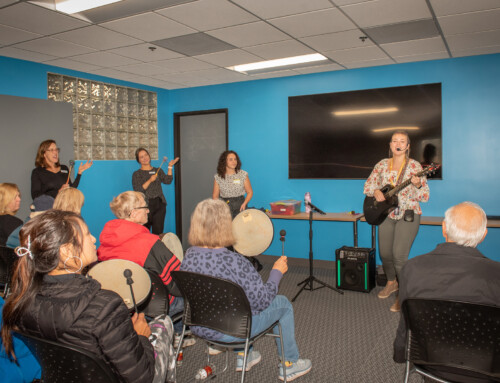 It can seem like there’s a new Alzheimer’s “breakthrough” almost every day. We sift through the headlines and pull together the relevant, reputable research updates for you. Here are 6 things you should know about Alzheimer’s and dementia research from the last month.
It can seem like there’s a new Alzheimer’s “breakthrough” almost every day. We sift through the headlines and pull together the relevant, reputable research updates for you. Here are 6 things you should know about Alzheimer’s and dementia research from the last month.
To learn about Alzheimer’s research in San Diego County, click here or contact Alzheimer’s San Diego at 858.492.4400.
1. Midlife obesity linked with higher risk of dementia
A new, long-term study finds that midlife obesity raises the risk of dementia in women.
Researchers at the University of Oxford in England found that women who had obesity at the beginning of the study were 21% more likely to develop dementia than women who had a “desirable” BMI:
- The study examined 1,136,846 women in the U.K.
- They had an average age of 56 years and were free of dementia at the start of the study, between 1996 and 2001.
The study distinguishes obesity from diet and calorie intake – the connection was seen specifically with obesity. The results were also adjusted for age, height, education, smoking, alcohol intake, use of menopausal hormones, residential area, and area deprivation. Dementia was also associated with low-calorie intake, low BMI and inactivity, but the association weakened over time.
- Authors explained that this likely means that low caloric intake and inactivity do not cause dementia and are instead consequences of pre-clinical behaviors of the disease.
The lead author, Sarah Floud, commented: “Some previous studies have suggested poor diet or a lack of exercise may increase a person’s risk of dementia. However, our study found these factors are not linked to the long-term risk of dementia. […] The short-term links between dementia, inactivity, and low-calorie intake are likely to be the result of the earliest signs of the disease before symptoms start to show.”
The study doesn’t necessarily imply causality – it’s possible that the causality might also be the other way around – the beginning stages of dementia contributing to obesity.
Read more at Medical News Today, Healio or read the study here.
2. Gantenerumab and solanezumab trials fail to prevent cognitive decline
The two drugs were being tested out by Eli Lilly and Roche, with a subsidiary, Genentech. Participants were healthy but had a rare genetic mutation that guaranteed they would develop dementia. The study, called DIAN-TU lasted five years and participants would receive monthly infusions or injections. The results of the study are still being analyzed and were to be presented on April 2 at scientific conferences in Vienna in April and in Amsterdam in July. An article by The New York Times explores this study in the context of a string of studies that have been unable to halt or prevent dementia by targeting amyloid. Within this context, currently, 30 out of the 46 Alzheimer’s trials in phase three are targeting something other than amyloid.
Read more at the New York Times and Reuters.
3. FDA approves insomnia drug, suvorexant, for Alzheimer’s patients
People with Alzheimer’s and other related dementias often experience disruptions in sleep and circadian rhythm. In early February, the Food & Drug Administration (FDA) approved Belsomra, an insomnia drug developed by Merck, for use among Alzheimer’s patients, the company announced this week. Belsomra is also known by its generic name, suvorexant. A study published in Alzheimer’s and Dementia investigated suvorexant’s potential in treating insomnia among patients who had mild-to-moderate Alzheimer’s disease.
- The study focused on 285 participants and found that suvorexant improved their total sleep time or TST.
Belsomra was already on the market – the FDA updated the label to include treatment for Alzheimer’s related dementia.
Read the study at Alzheimer’s and Dementia and more at Being Patient.
4. Scientists preparing to begin trial for BAN2401
Scientists in San Diego are preparing to screen thousands of people globally to find candidates who are well-suited to take an experimental drug that is designed to slow, and possibly stop, the progression of Alzheimer’s disease. The study will be led by the University of Southern California’s Alzheimer’s Therapeutic Research Institute — or ATRI — in Sorrento Mesa. Researchers are looking for people who do not have symptoms of Alzheimer’s but do have elevated levels of beta-amyloid. BAN2401 would attack the plaques and remove them from the brain. ATRI said in a statement it will screen about 9,000 people worldwide to come up with 1,400 who are clinically normal and have intermediate or elevated levels of amyloid in their brains. Researchers hope to screen the first participant by May 31 and complete enrollment in 18 to 30 months.
Read more at San Diego Union Tribune, 10 News, and Being Patient. Study locations and recruitment information can be found here.
5. COVID-19 & Alzheimer’s research
While a lot of research has to been put on hold during the COVID-19 pandemic, research involving animals presents a challenge. Research involving mice has to find a way to continue. Mice have been bred specifically over multiple generations to have mutations that make them more likely to develop dementia. However, modeling Alzheimer’s in animals is very difficult – mice don’t necessarily get Alzheimer’s disease, but scientists work hard to develop genetic models that mimic the disease.
First, scientists have to use Crispr to edit mouse embryos. Then, the mouse has to reach reproductive age before being bred with another mouse with the same mutation to guarantee that its pups will carry it. Those embryos have to be genetically modified to insert another risky genetic mutation and this cycle can take years.
Right now, scientists are hoping to keep those genetically modified mice alive during COVID-19 lockdown so as not to lose years of work. So far, the staff has been able to manage taking care of all the lines in these facilities as they are considered essential and can go into labs to feed and take care of the mice – but it’s uncertain how long that will be the case.
Read more at Quartz.
6. In rats…
These two topics have come up a lot in the news – these treatments have been tested in rats, and not yet in humans. It’s important to note that a lot of news publications will publish headlines about a breakthrough treatment, while burying within the story that the noticed occurrence was in rats.
Be aware that many things work out in rats, and other lab animals, that don’t necessarily translate into humans.
- Parkinson’s: New treatment targets two nerve systems at once, reverses impairments
-
A technique that was initially used to target brain cells associated with Parkinson’s (cholinergic neurons) has also been shown to target dopaminergic neurons
-
The intervention works by using a virus to deliver a genetic modification to the cholinergic neurons.
-
Through cell-to-cell interaction, stimulating the rats’ cholinergic neurons also stimulated their dopaminergic neurons.
-
This seemed to restore the dopamine-producing function in the dopaminergic neurons.
-
As a result of this, the rats made a complete recovery, including movement restoration and a reversal of postural impairment.
-
Read more at Medical News Today.
- Lithium: Low dosage of lithium may help prevent Alzheimer’s
-
It has been observed that those exposed to drinking water with higher levels of lithium were 17% less likely to develop dementia than people whose water contained barely any lithium
-
This study had several limitations, and this cannot necessarily be considered a casual relationship (read more])
-
In a study in Translational Psychiatry that micro dosages of lithium helped stave off Alzheimer’s in rats
-
-
To participate in clinical trials here are some links to nationwide registries:
-
Cleveland Clinic Healthy Brains Registry (nationwide)—take an online brain health assessment and learn about brain health studies.
-
Alzheimer’s Prevention Registry (nationwide)—get information and updates about participating in future Alzheimer’s prevention trials.
-
GeneMatch (nationwide)—enroll to get matched to Alzheimer’s genetics studies.
-
Brain Health Registry (nationwide)—sign up for an online study of brain health and learn about possible research-study opportunities.
-
Alzheimer Prevention Trials (APT) Webstudy (nationwide)—enroll to track memory and thinking skills and learn about Alzheimer’s trials
-
ResearchMatch (nationwide)—Matches you with research studies. Researchers need both healthy people and people with all types of conditions
To learn about Alzheimer’s research in San Diego County, click here or contact Alzheimer’s San Diego at 858.492.4400.




